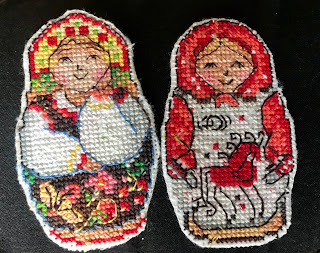This is a summary of a few Christmas projects that I couldn't write about in my weekly blog, because they were to be a surprise for someone who may have read the blog.
The first two were samples of Lagatera designs I wanted to try out and thought they would make good pinwheels - which they did. I'm very fond of pinwheels, as I have said many times. They are a very safe and convenient way to carry pins - and double as Christmas decorations!
I'm very fond of pinwheels, as I have said many times. They are a very safe and convenient way to carry pins - and double as Christmas decorations!

These fridge magnets came as a kit of four. I haven't made the other two. On plastic canvas, they were designed for embroidering in the hand, but I had to mount the plastic on cotton and use a hoop because my I developed pain in my hands from holding them. A bit tedious - but a lovely result.
I also abandoned the tiny magnetic pieces provided in the kit for lengths of magnetic strip purchased at a hardware store. Now, of course, I have enough for dozens of magnets!
 The magnum opus (or, in fact, magna opera) was a garlic bag, which began as a Jenny McWhinney project from Inspirations Magazine 41.
The magnum opus (or, in fact, magna opera) was a garlic bag, which began as a Jenny McWhinney project from Inspirations Magazine 41. I really liked the look of it and went looking for the materials to make it. Sourcing the hessian proved challenging.
By the time I was looking, Jenny no longer had the original hessian but I sourced something equivalent. I also decided that silk was not my choice for something that would get handled and used frequently in a kitchen. Furthermore, I decided few kitchens could easily accommodate a bag on a dowel, and even the most regular user of garlic did not need a bag of that size. So I adapted.
I used stranded cotton, inserted plastic stiffener in the opening and reduced the hanging tabs from two to one. It easily holds 6 head of garlic - more than most families need at any one time.
I had intended to make two of these, one for each of my daughters' families, but got to thinking of the message of a rooster on a garlic bag. One of my daughters keeps chickens, so it seemed appropriate enough, but if you didn't keep chickens, was the bag suggesting the best use of garlic was as a flavouring in chicken casserole?
I reckon it works.
I had a lot of fun with these - and great satisfaction.


 This is the front and back of Fallahi, a pincushion from Inspirations 72 which I bought as a kit years ago and decided to finish as a gift for a granddaughter.
This is the front and back of Fallahi, a pincushion from Inspirations 72 which I bought as a kit years ago and decided to finish as a gift for a granddaughter.I adapted it to hang (a pincushion entirely surrounded by tassels did not seem like a good idea to me) and added black pins. We were both happy with the result.

I wanted to give one of my daughters a pair of scissors but discovered it is considered bad luck to give scissors as a gift. Fortunately, the bad luck can be avoided by requiring the receiver to pay for the scissors, so the protocol is to tape to the gift a coin which must be returned.

A few other Christmas gifts have been covered in earlier posts which the recipients were unlikely to see. Finally, these two were gifts for November birthdays. The hat is a mix of cotton yarns as an experiment for someone allergic to wool.
The wrist warmers below are from a Marie Wallin kit


































 This is what it looks like inside - not very tidy, but it does hold the seam folds down, out of the way.
This is what it looks like inside - not very tidy, but it does hold the seam folds down, out of the way.






